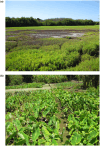The Scientific Benefits of a Statewide, Standardized, Coastal Wetland Monitoring Program in Hawa'i
- PMID: 40264845
- PMCID: PMC12011549
- DOI: 10.1002/ece3.71293
The Scientific Benefits of a Statewide, Standardized, Coastal Wetland Monitoring Program in Hawa'i
Abstract
In this viewpoint, we provide a scientific justification for a statewide, standardized, coastal wetland monitoring program for Hawai'i, USA. Hawaiian coastal wetlands provide important habitat for endangered waterbirds, invertebrates, plants, and the Hawaiian hoary bat ('ōpe'ape'a; Lasiurus semotus) as well as support Indigenous food systems. Currently, numerous agencies and groups in Hawai'i collect data on coastal wetlands, but information is not typically shared and methods are not standardized. A statewide, standardized, coastal wetland monitoring program with a centralized database would allow managers to keep better track of progress toward restoration goals, population changes of conservation-reliant species, outbreaks and impacts of avian botulism, rates of coastal salinization, and many other critical issues across space and time. Monitoring combined with targeted research could fill critical knowledge gaps about the types, functions, values, and biodiversity of Hawaiian coastal wetlands. Ultimately, the improved knowledge gained from long-term coastal wetland monitoring could inform landscape-scale restoration actions and adaptive management of coastal wetlands under sea-level rise and climate change.
Keywords: adaptive management; agricultural wetlands; climate change; coastal wetlands; endangered waterbirds; environmental monitoring; loʻi kalo; sea‐level rise.
Published 2025. This article is a U.S. Government work and is in the public domain in the USA. Ecology and Evolution published by British Ecological Society and John Wiley & Sons Ltd.
Conflict of interest statement
The authors declare no conflicts of interest.
Figures

References
-
- Bantilan‐Smith, M. , Bruland G. L., MacKenzie R. A., Henry A. R., and Ryder C. R.. 2009. “A Comparison of the Vegetation and Soils of Natural, Restored, and Created Coastal Lowland Wetlands in Hawaiʻi.” Wetlands 29, no. 3: 1023–1035. 10.1672/08-127.1. - DOI
-
- Buchsbaum, R. N. , and Wigand C.. 2012. “Ch. 14. Adaptive Management and Monitoring as Fundamental Tools to Effect Salt Marsh Restoration.” In Tidal Marsh Restoration, edited by Roman C. T. and Burdick D. M., 213–231. Island Press.
-
- Burney, D. A. 2002. “Late Quaternary Chronology and Stratigraphy of Twelve Sites on Kauaʻi.” Radiocarbon 44, no. 1: 13–44.
-
- Burney, D. A. , James H. F., Burney L. P., et al. 2001. “Fossil Evidence for a Diverse Biota From Kauaʻi and Its Transformation Since Human Arrival.” Ecological Monographs 71, no. 4: 615–641.
-
- Chesapeake Bay Program . 2024. “Monitoring.” https://www.chesapeakebay.net/what/programs/monitoring.
LinkOut - more resources
Full Text Sources
Research Materials
Miscellaneous

